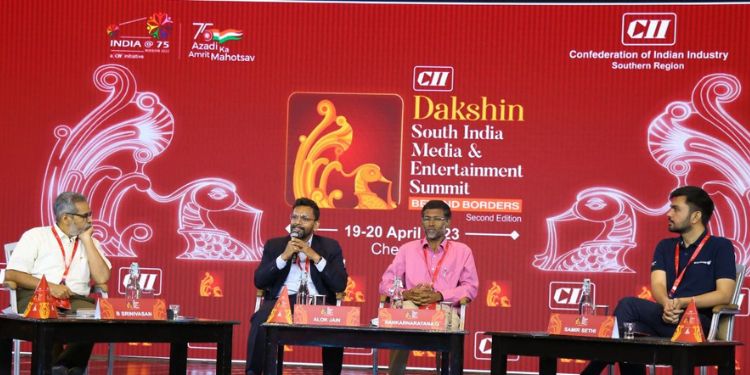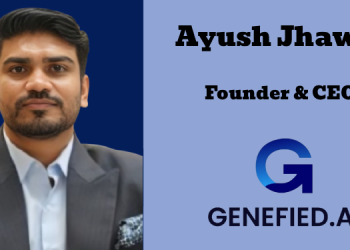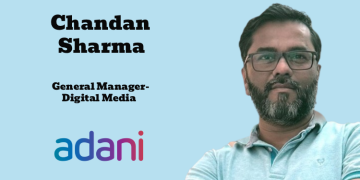CII Dakshin, a two-day conference organised by the Confederation of Indian Industry, witnessed a panel on April 20 on the topic, ‘How Does India Watch TV in 2023?’.
Moderated by B Srinivasan, Managing Director, Ananda Vikatan Publications, the panelists were Alok Jain, Business Head, Disney Star India for Telugu, Kannada, Bangla and Oriya (TV+OTT); Samir Sethi, Vice President & Head of Brand Marketing, Policybazaar; and Sankaranarayana Gopalan, CEO, Asianet Cable Vision.
Srinivasan asked the panelists, “There have been a lot of questions around the future of television with the assault of the digital platform and this is how the TV industry dented the print industry 30 years ago. So how are you coping and what would you say are the steps you have taken?”
Jain responded, “I am a firm believer that both the TV and the OTT are going to coexist. Lots of data in front of us to see. Recently we have seen IPL, on television and OTT, both have grown. In India there is a huge growth potential and there are a lot of people who are still going to come into the entertainment space. How the future will shape up for both OTT and TV, depends upon how both the industries work together. We as Disney Star, a content maker, work across the platforms, in the movies, TV, OTT. So I think that little shape and form will change but all of them are going to coexist is the firm belief which we have. We have seen with IPL, with many of the content pieces like big movies, RRR and Pushpa, after a humongous success on the theatres, they were humongous success on OTT. When they came on TV, Pushpa had 25 plus TVR in the Telugu market, Kantara had a great TVR. So for great content, there is going to be immense potential across platforms.”
Gopalan said, “One way of looking at things is, we have been watching TV from our living rooms with our family for the last 30 years, now that three to four-hour window has expanded to a 24-hour window. Basically we can watch it anytime. So that way there is an additional opportunity for video consumption. Second, we used to watch video on conventional television screens. Today there is a TV screen in our pockets every time, any time. There are some 85 crore TV screens in the form of smart phones, so that is again an expansion of opportunity for video consumption. It’s a huge opportunity for video consumption.”
On how OTT is going to cannibalise the TV industry, he noted that stakeholders, including broadcasters, distribution platforms and others, need to work it out in such a manner that overall, the industry grows and ultimately the subscriber, the viewer is king.
“We need to play the game keeping the viewer in mind. There has been a tendency among some of the OTT players to go aggressive, promote OTT by subsidising, by cutting cost on OTT subscription. That kind of a trend actually can work negatively for the entire video industry. That needs to be kept in mind to ensure that both of them will coexist for a long period to come.”
Sethi remarked, “This has become an extremely hot topic since the last few years, the rise of digital is being equated to the fall of television. I don’t think this is the right equation. We will have to understand this debate, in some ways, as imported from the US where there was a huge phenomena of cord cutting since the last one decade. We will have to understand some numbers in context. In the US the average monthly household cable bill is about 100 to 150 US dollars, that is for a nuclear family. In India, a majority of the households are single screen households, they have just one television set in the entire house and they pay on an average about 200 to 300 rupees a month. So for about 200 to 300 rupees a month, the family of 4 to 5 people or even more gets their dose of entertainment for the entire month. You will have the kids show, sports, live news, general entertainment and everything. Is TV dying – definitely no. Is the share of time spent on entertainment everyday being cut from television and dedicated to digital – to some extent yes. But I see for the next few years both TV and digital coexisting. A lot of digital content consumers also use it to supplement their television entertainment. I don’t see television getting a major hit at least for the next five to seven years.”
The discussion veered to distinction in quality parameters, innovation and measurement of television and OTT.
Jain said, “There are many genres which TV cannot do. For example there is horror, there are many other genres which are individual watching, which the TV cannot cater to. There are single TV houses and the TV is placed in a manner where the women can watch it from the kitchen.”
“Second, when we look at the cost of content making and time duration, it takes approximately 12 to 18 months to make a piece of content. Today OTT is making 2500 hours of content in India while TV is making 1 lakh hours of content. The number of hours of content every individual consumed per day is 3.5 hours. So that is the amount of consumption which happens in India, this is a little bit of a long rope where the OTT will be able to capture. There are things which people will like to watch on TV there are things people will like on OTT and that’s how the business will move forward,” he added.
He compared the scenario to ecommerce and physical retail, where ecommerce is still less than 10pc.
“Innovation will be required both on OTT and TV. OTT to figure out what kind of genres they cater, how do they make it at a scale, how do they make it economic. Similarly TV will also see how they find their scale and how they continue driving some of the innovation to make a mark,” he added.
Srinivasan asked Gopalan, “Over the last few years there has been a consistent attempt by broadcasters to actually increase the price of their channels either as a bouquet or as individual and this has led to a lot of blackouts and push back from the cable TV operators or the industry at large. Do you see that in the age where generally the cost to the consumer is going down it is reasonable and expected that your subscription rates keep going up and do you think this is feasible and where do you think this will actually go from here?’
Gopalan responded, “The country has invested a huge amount, 40 to 50 thousand crores in digitalisation of television. The objective of that program was basically to give the choice to the subscriber to pick and choose the channels he wants to watch rather than being dumped with unwanted channels so that he can optimise the cost he spends. The expectation of the regulator and the entire country was this will drive down the subscription the subscriber is going to pay. But what has actually happened after 2019 is the subscription rates have started going up. MRP of the channels were steeply increased by the broadcasters, in some cases to the extent of 300 to 400 pc overnight. January 2019 to February 2019 it went up by 400pc in some cases.”
He explained, “Every broadcaster tries and bundles not so popular channel with a popular channel to ensure more viewership and that cost is borne by the subscriber. It’s probably the entire ecosystem, the broadcasters, distributors have to think. If you look at the macro picture, we have some 30 crore homes, 21 crore TV homes, so 9 crore homes don’t have TV itself. And out of the 21 crore, only 13 crore are paying.”
“Nearly 60 pc of Indian homes are not paying for TV content today, and if you look at the growth of Free Dish, it has been rampant in the last three to four years. They reached the 5-crore mark because the customer doesn’t want to pay this kind of amount. Maybe the time has come today if you look at 2019 to 2023, in the last four years the paying subscriber base has come down by 30pc. Now to compensate for the 30pc drop again broadcasters look at increasing the subscription fee by another 30pc. We need to look at 16 crore homes not paying and how to tap that market. That will help the industry overall to grow, broadcaster revenues will grow, subscribers will be happy to pay, some rework has to be done to ensure that this industry grows overall,” he added.
“You run a digital first company and I was very surprised when you were saying that you spend almost 90 pc of your brand promotion revenues on television. How does TV impact your business and how do you see it moving forward?”, posed Srinivasan to Sethi.
He responded, “We have been advertising consistently on television for over a decade and unlike a lot of traditional advertisers who would do two to three campaigns a year based on strategic reasons like seasonality, product launch etc., we are present on television almost every month. We advertise almost every two out of three days on TV and the reason we have had the confidence to do it very consistently and at scale is because we get a lot of immediate returns from it apart from the long-term brand building benefits of cost.”
“We do large scale national television campaigns. In a very clear manner we are able to isolate the impact we are getting from it, the delta we are getting from it and attribute it to the television advertising. We calculate the cost we are incurring to get that kind of impact in terms of number of visitors coming to the website and number of people actually buying our products, and that mathematics has somehow worked for us very well and continues to work for us even now. One of the debates a lot of people have when they differentiate between advertising on digital versus advertising on television is a measurability of impact. A lot of people talk about the fact that when you advertise on digital basis the number of clicks you are getting you are able to clearly measure and attribute the impact from a digital campaign, while that is absolutely true, it is equally or to some extent in a very similar manner true on television as well. You are doing a large scale national campaign or even a regional campaign concentrated in a particular state, you get TV hotspot data, few days after executing the campaign and what we have the ability to do as a digital business is to plot the TV ads for data along with the website visit data and see how well is the genre, channel, weekdays versus weekends, working for us,” he elaborated.
Sethi further added, “In some cases there is a very direct correlation, sometimes it is slightly contrary to what we see from BARC but it is not only a function of how many people are viewing your ad or how many people are viewing a particular show, it’s also about the affinity, inclination of the people to respond to your category. Some people watching sports might be more likely to buy a certain category versus people watching news, while the mix of audience might broadly be similar, they are all males within a certain age. Every category, every company, will have to do their own analysis to figure out what’s working best for them. But the television has been working very well for us and very consistently.”
The last question of the session was for Sethi by Srinivasan, led by David Ogilvy’s famous remark on one half of advertising working but not knowing which half – in the context of television advertising versus performance marketing.
Sethi responded, “In economics there is a law of diminishing marginal utility, in advertising also there is a law of diminishing marginal reach for every rupee spent. So when you try and scale beyond a certain reach number you are going to get slightly less for what you pay. This is a trade-off you have to do between efficiency and scale, this is inevitable. When you are talking about what kind of returns you get when you advertise on brand building. In this case, especially television, it depends from advertiser to advertiser. In a category that has multiple sales channels offline, being a major component of it you are happy as a brand to just build a positive perception of your brand, get more consumer love because the actual transaction is going to happen maybe a week later or a month later, you are just trying to leave a positive impression of yourself in the consumers or the viewers mind, so there the purpose is very different. You are okay if you’re not getting a lot of immediate return like performance marketing would give you through a click etc. When the transaction is happening online and the transaction can actually happen within some minutes in some cases, some food delivery apps would advertise for some very delicious tasting food and consumers would on an impulse order the same thing in a matter of 10 minutes. Something like insurance, sometimes people after looking at impactful advertising, can respond in a matter of an hour also so when you have the opportunity as a marketer to close the transaction in a very quick manner in the same environment in which the consumer is viewing you, you would try and fine tune your messaging also accordingly, you would try and communicate a good value proposition, leave a very convincing call to action apart from obviously leaving a positive impression of yourself in the consumers mind. It’s more about the business objective, category and predominant sales channels. I think the essence of your question if TV also be commercially viable from an advertising point of view, from the advertiser side, yes it definitely can.”

















